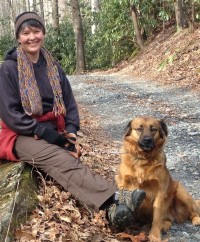It is wonderful to discover yet another layer of generosity within trees and shrubs already on my planting wish-list. Where do I begin?
So I have this spot I want to plant a tree. It’s way out back along our fence line, behind and to the right of the chicken house. The spot has pretty good soil that tends on the wet side.
My initial personal hopes for the tree are 1) beautiful color in the Autumn since it’s the focal point of the main kitchen window 2) to be wind-worthy and ease the winter gale that blows through there.

In a larrapin garden it kind of goes without saying that the generosity of the plant will also be a deciding factor. What gifts will it provide songbirds, wildlife, pollinators, the soil, the gardeners? So I’m consulting THE book, the subject of my post last time: The Living Landscape by Rick Darke and Doug Tallamy. There’s a treasure trove of generous plants in there! So many gifted and beautiful trees and shrubs there’s just not time or space to plant them all though I appear to be giving it a try.

I’ve been wanting a sweet gum tree (Liquidambar styraciflua) since I adore the spectrum of fall colors on one tree and the gorgeous star shaped leaves. I know, I know, people hate those spiny sweet gum balls. There are even people who have their trees *sprayed* to make the tree drop the tiny blooms and not produce the fruit. I kid you not…so hard to believe I’m going to provide the source link.
So no, don’t plant this baby where you’ll sprain an ankle on your sidewalk or where your kids play barefoot. If you have one already in those areas, try sweeping your walk and putting shoes on your kids during ball drop season. Problem solved…without sprays? <the curmudgeon gets ahold of herself>
Web photo above shows the fall color and the beautiful leaves. Also shown, those scary prickly fruit.
ANYWAY, at first glance sweet gum only rates medium on the gifts to wildlife chart. Meaning fewer little cool symbols in that handy dandy index compared to some trees where the little symbols stretch across the page:
But then there’s a note out to the side on the chart, “Tiny seeds are favorites of wintering finches. Leaves host beauties like the luna moth.” There ya go. So the scary prickle balls feed the finches and the leaves are for my beloved Luna moths. “Sold” my heart yells!
But there are other things to check out since the expression “Right plant. Right place.” is wise and two-part advice.
So I jump over to a favorite website, the Plant Finder tool by Missouri Botanical Gardens, which will tell me what kind of soil and situation it likes as well as any known weaknesses to noxious poxes. All checks out fine there, except the caution on God’s finch feeders… The tree is not reliably winter hardy in the northern parts of zone 5, which should hopefully cover my zone 6 site even with elevation and cold winter wind.
About the wind though… While there’s no specific reference to “weak wood” or other cautionary wind items on that site I want to dig deeper. A web search finds the tree listed in the medium-high wind resistance category in a hurricanes and trees website from LSU. Good sign!
This tree is looking like it’s getting a thumbs up for a test run at Five Apple farm when something else happens…..
Stay tuned next week for the exciting part! Ok, “exciting” to my interest in the medicinal value of plants. That’s a teaser. See you then! 🙂 (update: Here’s a link to the exciting part…. http://larrapin.us/the-many-medicines-of-native-plants/
love, Leigh
———————-
I would love to have you as a regular reader! Subscribe to get one email a week (max) about the larrapin goings-on at Five Apple Farm. Occasional garden book giveaways too! It’s all free of course and your info isn’t shared. There’s also the Facebook page, Pinterest boards and even Instagram now and then. Fun aplenty!






